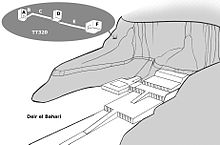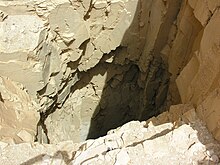Cachette from Deir el-Bahari

The cachette of Deir el-Bahari with the scientific grave number DB / TT320 is an ancient Egyptian tomb in the necropolis of Deir el-Bahari north of Thebes . The cachette served as a mummy depot to protect against grave robbers and, according to today's knowledge, was laid out in the 22nd dynasty under Scheschonq I. Originally the grave for Pinudjem II was built.
history
The Deir el-Bahari cachette was discovered in 1871 by the brothers Ahmed, Soliman and Mohammed Abd el-Rassul. The Abd el-Rassul family withheld the discovery of the grave, as it was a welcome source of income for them. In the years after the discovery, they kept selling some finds from the grave. Finally, the attention of Gaston Maspero , who at the time was director of the Egyptian Museum in Bulaq / Cairo and head of the Egyptian Supreme Council of Antiquities , became aware . He suspected the discovery of a tomb from the 21st dynasty .
Maspero traveled to Upper Egypt at the end of May 1881 to research the matter. Ahmed Abd el-Rassul was arrested on April 4, and one of his brothers was arrested shortly afterwards. It wasn't until June 25, 1881 for one of the brothers to admit the discovery, and on July 6, he led the museum's delegation, led by Emil Brugsch , Maspero's assistant at the time, to the tomb.
Around 40 sarcophagi and around 6,000 other finds were seized in the cachette and the temporary storage of the Abd el-Rassul family . Now it was clear that it was not a grave from the 21st Dynasty ( Third Intermediate Period ), but a depot for reburied pharaoh mummies to protect against grave robbers . Since the discovery was meanwhile known in the area, Brugsch and Ahmed Kamal acted very quickly. Within 48 hours, all finds were loaded and temporarily stored in Luxor in order to later be transported to Bulaq on the museum ship (the Menshiéh ) . In this hurry, a scientific documentation was dispensed with, which today turns out to be a major omission.
In 1998, the Institute of Egyptology and Coptic Studies at the University of Münster, together with the Department of Egyptology of the Russian Academy of Sciences in Moscow, initiated further investigations. The new excavations were led by Erhart Graefe . During these excavations, additional quantities of objects and fragments were found. The degree of destruction of many of these finds indicates the rough handling of them by the delegation led by Brugsch.
architecture
One reaches the grave through an approximately twelve meter long access shaft. From there you come to an approximately 7.5 meter long and 1.4 meter wide corridor with built-in steps and a ceiling height of approximately 1.8 meters. At the end of the corridor, turn right at an angle of approx. 90 ° into the actual grave. The total length of the plant is approx. 61.80 meters. About halfway down the corridor there is a niche on the left, about 7.8 meters long and 3.9 meters wide. Following the passage one arrives at the main burial chamber. The entire system has a ceiling height of about two meters.
The most important finds
| Surname | dynasty | Mummy / coffin | Remarks | |
|---|---|---|---|---|
| 1 | Ahhotep I / II. | 17/18 | D / - | |
| 2 | Ahmose | 17th | - / * | Daughter of Seqenenre and Ahhotep I. |
| 3 | Ahmose Henuttamehu | 17th | * / * | Daughter of Ahmose Inhapi |
| 4th | Ahmose Inhapi | 17th | B / - | Presumably Seqenenre's concubine |
| 5 | Ahmose Meritamun I. | 17th | * / - | Mummy in the coffin of the head administrator Seniu |
| 6th | Ahmose Nefertari | 17th | D / D | Wife of Ahmose I , mother of Amenophis I (the mummy Ramses III was also in the coffin ) |
| 7th | Ahmose Sapair | 17th | * / * | Probably the son of Seqenenre (?) (The coffin also contained the mummy of an anonymous child) |
| 8th | Satkamose | 17th | * / - | The mummy was in Pediamun's coffin |
| 9 | Ahmose I. | 18th | D / D | |
| 10 | Amenhotep I. | 18th | C / C | Mummy in the coffin of Djehutimose |
| 11 | Baket | 18th | * / * | |
| 12 | Djed Ptahiuefanch | 21st | F / F | 2nd or 3rd prophet of Amun-Re , (+ figure of Osiris and papyrus ) |
| 13 | Hatshepsut | 18th | - / - | Just a wooden box with a mummified liver or spleen and a broken tooth |
| 14th | Hennutaui | ? | B / B | Wife of Pinudjem I. |
| 15th | Isisemcheb | 21st | F / F | |
| 16 | Maatkare | 21st | F / F | Daughter of Pinudjem I. and Hennutaui |
| 17th | Masaharta | 21st | F / F | Son of Pinudjem I. (+ leather tent fragments) |
| 18th | Merimose | 18th | - / - | Viceroy of Kush (only canopic jugs ) |
| 19th | Nebseni | 18th | F / F | Clerk |
| 20th | Neschons | 21st | F / F | Wife of Pinudjem II (+ canopic jars, figure of Osiris, papyrus, faience jugs ) |
| 21st | Nesitanebashru | 21st | F / F | Daughter of Pinudjem II and Neschons (+ copper jugs, Osiris figure, canopic jars, papyrus) |
| 22nd | Nedjement | 21st | * / * | Wife of Herihor (+ canopic box , figure of Osiris, papyrus) |
| 23 | Paheripedjet | 20th | - / * | The coffin contained the mummy Rais |
| 24 | Pediamun | 21st | - / * | The coffin contained the mummy Ahmose Sitkamose |
| 25th | Pinudjem I. | 21st | D / C | + 2 shabti boxes , mummy was in Thutmose I's coffin |
| 26th | Pinudjem II | 21st | F / F | + Osiris figure, papyrus and canopic jars |
| 27 | Rai | 17th | * / B | Nurse of Ahmose Nefertari |
| 28 | Ramses I. | 19th | - / C | The coffin contained the mummy of an "unknown" Tetisheri |
| 29 | Ramses ii | 19th | D / D | |
| 30th | Ramses III. | 20th | D / D | |
| 31 | Ramses IX. | 20th | F / - | |
| 32 | Seniu | 21st | - / * | Supreme administrator of the Amun |
| 33 | Seqenenre | 17th | D / D | |
| 34 | Seti I. | 19th | B / B | |
| 35 | Sa-amun | 17th | D / D | Son of Ahmose and Ahmose Nefertari |
| 36 | These | ? | - / - | Royal scribe (canopic jug only) |
| 37 | Satamun | 17th | * / * | Daughter of Ahmose I and Ahmose Nefertari |
| 38 | Sutymosis | ? | - / - | Singer from Ahmose-Nefertari (+ canopic coffin) |
| 39 | Taueret | 21st | F / F | First of the Harem of Amun-Re |
| 40 | Tetisheri | 17th | - / - | Probable mother of Seqenenre (labeled mummy bandages only) |
| 41 | Thutmose I. | 18th | C / - | Mummy in the coffin Pinudjem I. |
| 42 | Thutmose II. | 18th | C / C | |
| 43 | Thutmose III. | 18th | D / D | |
| 44 | Wepmose | ? | - / - | Royal scribe (canopic jug only) |
| 45 | Wepwawetmose | ? | - / - | Plenipotentiary of the Army (only canopic jug) |
Eight other unknown mummies were also found. A, B, C, D, E, F indicate the location in the cachette, * means that the location was not documented. Table according to Reeves / Wilkinson and Dodson / Hilton.
literature
- Émile Brugsch-Bey : La tente funéraire de la princesse Isimkheb, provenant de la trouvaille de Déir-el-Bahari. sn, Cairo 1889.
- Aidan Dodson , Dyan Hilton: The Complete Royal Families of Ancient Egypt. Thames & Hudson, London 2004, ISBN 0-500-05128-3 .
- Erhart Graefe : Preliminary report on the first campaign of a follow-up examination of the royal cachette TT 320 by Deir el Bahri. In: Communications from the German Archaeological Institute, Cairo Department (MDAIK). Vol. 56, 2000 ISSN 0342-1279 , pp. 215-221, plates 26-29.
- Salima Ikram , Aidan Dodson: Royal Mummies in the Egyptian Museum. American University in Cairo Press, Cairo 1997, ISBN 977-424-431-1 .
- Gaston Maspero : Les momies royales de Déir el-Baharî (= Mémoires publiés par les membres de la Mission Archéologique Française au Caire. Vol. 1, Fasc. 4, ZDB -ID 447735-2 ). Leroux, Paris 1889, digitized .
- Gaston Maspero: Guide to the Cairo Museum. 4th edition. Printing Office of the French Institute of Oriental Archeology, Cairo 1908, pp. 99 f., 181.
- Nicholas Reeves , Richard H. Wilkinson : The Valley of the Kings. Mysterious realm of the dead of the pharaohs. Weltbild-Verlag, Augsburg 2002, ISBN 3-8289-0739-3 , pp. 194–197.
- Catharine H. Roerig: Deir el-Bahri, royal mummy cache. In: Kathryn A. Bard (Ed.): Encyclopedia of the Archeology of Ancient Egypt. Routledge, London 1999, ISBN 0-415-18589-0 , pp. 242-243.
Web links
Individual evidence
- ^ N. Reeves, RH Wilkinson: The Valley of the Kings. 2002, p. 197
- ^ Gaston Maspero: Les momies royales de Déir el-Bahari. 1889
- ↑ Completed projects (Erhart Graefe). Cachette TT 320. ( PDF file )
- ^ N. Reeves, RH Wilkinson: The Valley of the Kings. 2002, p. 196.
- ^ A. Dodson, D. Hilton: The Complete Royale Families. 2004.
Coordinates: 25 ° 44 ′ 12.5 ″ N , 32 ° 36 ′ 18.1 ″ E
